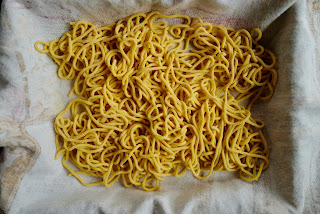I posted my first article on this website ten years ago. I wrote about bigoli, a Venetian spaghettoni that I made on a hand-turned pasta press called a torchio.
Since writing that first post, I’ve made a lot of pasta with my torchio using different bronze dies that craft a diverse range of pasta shapes. I learned that certain dies produce better results when extruding a particular kind of pasta dough. I now use one type of dough when making a fine, long pasta (here) and another when I want a short pasta (here).
Yet even with my pasta journal full of tested recipes, I still experiment: sometimes to affect a change in my pasta’s texture and/or flavor; sometimes based upon the ingredients that I have—or don’t have—on hand; and, occasionally, just for fun.
I want to share another torchio pasta dough recipe that I recently developed. I aimed to make a chewy-textured long string pasta that extruded without excessive sticking. To realize these qualities, I use my standing mixer fitted first with a paddle and then with a dough hook to knead the dough.
115 grams Central Milling Organic Semolina
115 grams Central Milling Organic Type 00 Normal
4 grams Diamond Crystal kosher salt
2 medium eggs
water
1) Put the 230 grams of flour and salt into the bowl of a standing mixer equipped with a mixing paddle. Mix to combine the flour and salt.
2) Place a glass beaker on a scale, tare the scale and add the eggs to the beaker. A medium-grade egg weighs approximately 50 grams, so the eggs in the beaker should weigh about 100 grams. Add water to the beaker so that the egg mixture weighs a total of 112 grams. If the 2 eggs weigh more than 112 grams, remove enough egg white to reduce the weight of the eggs to 112 grams. Whisk the beaker’s contents together.
3) Turn on the mixer and set it at its lowest speed. Slowly add small amounts of the beaten egg mixture into the flour. Patiently wait between each small pour to allow the mixer to incorporate the egg into the flour. From start to finish, the step of adding the egg mixture to form the dough should take about 3 minutes.
4) When the dough comes together (see photo above), turn off the mixer and replace the paddle with the mixer’s dough hook attachment. Turn the mixer back on to low and knead the dough for 10 minutes. Remove the dough from the mixer.
5) Form the dough into a log shape that will fit into the torchio’s chamber. Very tightly wrap the dough log twice in plastic film and let it rest at room temperature for 30 minutes. Tightly wrapping the dough helps hydrate the dough.
6) After 30 minutes, unwrap the dough and knead it by hand for 30 seconds to firm up the dough. Ready your chosen torchio die and place the dough in the torchio’s chamber. Set the piston into the chamber and turn the handle. Cut the pasta at your desired length. The pasta should feel just a tad sticky. When making a long string noodle, I dust the cut pasta with semolina flour before placing the pasta on a tray to dry out for an hour or so.
The above recipe makes enough pasta to serve 4. When I began developing this recipe, I used 115 grams of flour, one egg and some water. This produced a dough that happily skirted around the dough hook in the mixing bowl. So I doubled the qualities and problem solved.
I bought a new bronze die to use with this dough: a 3mm square spaghetti die that Emiliomiti (here) calls spaghetti alla chitarra. Per Oretta Zanini De Vita’s Encyclopedia of Pasta, the pasta chitarra (guitar) ”…consists of a wooden frame (beech or other neutral wood) strung with parallel steel wires.” The pasta maker places a thick-ish sheet of pasta on top of the “strings”. Zanini De Vita continues: “[u]nder the uniform pressure of a rolling pin, the strings cut the pasta to make the famous maccheroni, which are a sort of square spaghetti about 12 inches (30 cm) long. They are boiled in salted water.”
In Molise maccheroni alla chitarra is called crioli, in The Marche stringhetti, and in Lazio it is tonnarelli. If you like to make cacio e pepe, the above dough paired with the tonnarelli die will make you very happy. I also used the dough in my torchio fitted with a No. 98 rigatoni die. The pasta tasted great, but the tubes didn’t hold their shape after extruding.
I originally started this food blog, in part, as a lark, thus its silly name. If I had known I’d be at it for ten years, I might have considered a more serious moniker. But…maybe not. What could possibly be more Serious than a Bunburyist? Another ten years?







